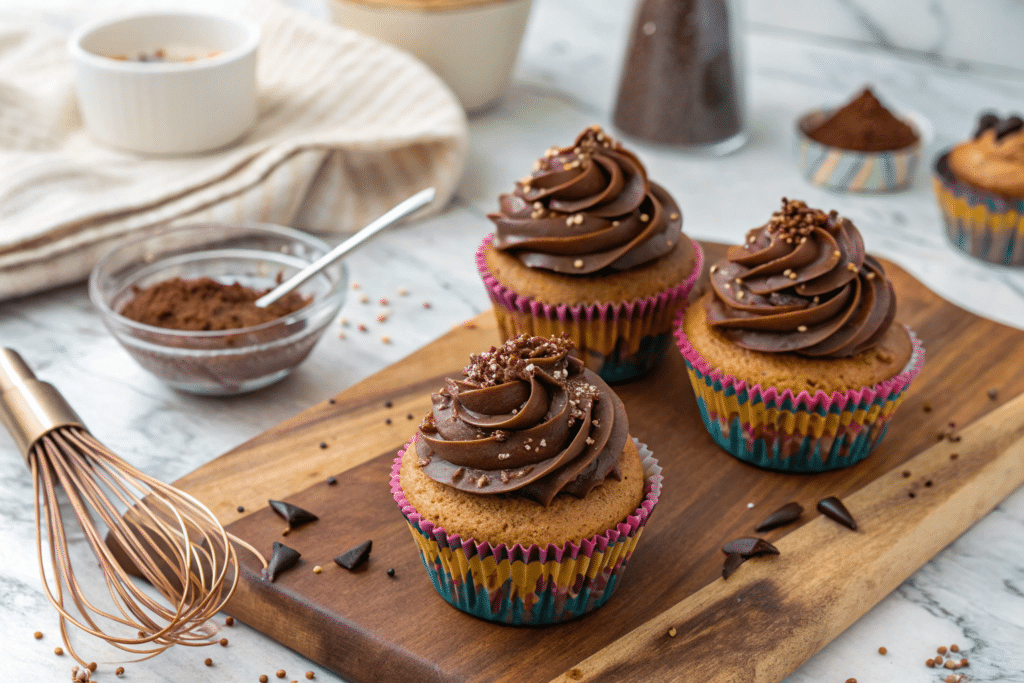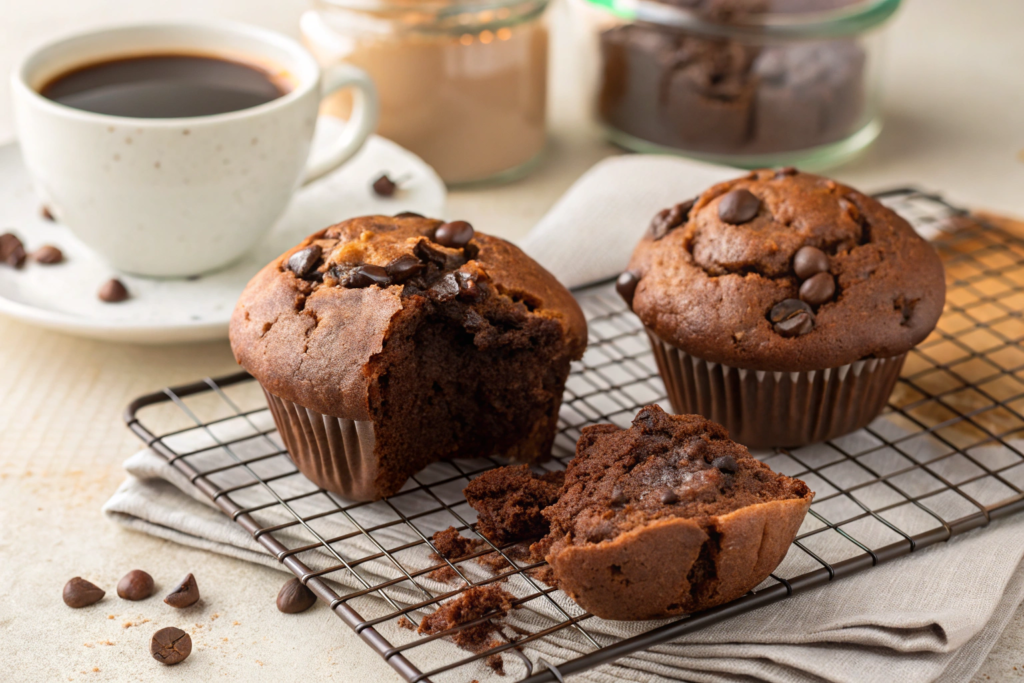Chocolate cupcakes and muffins may look similar at first glance, but they have distinct differences that go beyond just the presence or absence of frosting. Understanding these differences can help you choose the right treat for any occasion, whether you’re baking at home or selecting a snack from your favorite café.
Many people ask, “What is the difference between chocolate cupcake and muffin?” The answer lies in their ingredients, texture, preparation methods, and cultural significance. Whether you’re looking to whip up a batch of sweet chocolate cupcakes for a birthday party or preparing a healthier muffin for breakfast, knowing these distinctions will guide you to the right recipe.
Table of Contents
🍫 What is a Chocolate Cupcake??

A chocolate cupcake is essentially a small cake that is baked in a cup-shaped mold and often topped with frosting. The texture is light, fluffy, and sweet, resembling that of a larger cake.
Key Ingredients
- Flour – Usually all-purpose flour for a soft texture
- Sugar – Higher sugar content for sweetness
- Eggs – Help with structure and moisture
- Butter or Oil – Adds richness and moisture
- Leavening Agents – Baking powder and baking soda for a light, airy texture
- Chocolate or Cocoa Powder – Gives the cupcake its signature flavor
The Role of Frosting
One of the defining features of a cupcake is its frosting, which enhances its sweetness and provides an opportunity for decorative flair. Popular frosting options include:
- Buttercream
- Cream cheese frosting
- Ganache
- Whipped cream
Presentation & Decoration
Cupcakes are often elaborately decorated, making them perfect for celebrations like birthdays and weddings. Decorations may include sprinkles, edible glitter, and piped designs.
For more on how to perfect your cupcakes, check out our Secret to Moist Cupcakes article, which dives into techniques to keep your cupcakes tender and flavorful.
🧁 What is a Chocolate Muffin??

µA chocolate muffin is a type of quick bread with a denser texture and less sweetness than a cupcake. Muffins often incorporate whole grains, nuts, or fruit and are usually eaten without frosting.
Key Ingredients
- Flour – Often a combination of all-purpose and whole wheat flour
- Less Sugar – Muffins tend to have lower sugar content
- Eggs – Bind the ingredients together
- Less Butter or Oil – Lower fat content compared to cupcakes
- Leavening Agents – More baking soda to create a denser crumb
- Mix-ins – Nuts, fruits, or seeds for added texture and nutrients
Muffin Tops
Muffins often have a slightly domed, crisp top that contrasts with their moist interior. Some muffins feature a streusel or coarse sugar topping for added texture and flavor.
For more technical baking tips, our Baking Poke Cakes article provides insights that can be applied to both cupcakes and muffins.
🔍 What is the Difference Between Chocolate Cupcake and Muffin : the Key
1. Sugar Content
Cupcakes contain more sugar, giving them a sweeter flavor, while muffins have a more subdued sweetness.
2. Fat Content
Cupcakes use more butter or oil, resulting in a richer texture, whereas muffins tend to have less fat and may include healthier alternatives like yogurt or applesauce.
3. Leavening Agents
Cupcakes rely on baking powder for a fluffy texture, while muffins use more baking soda, which reacts with acidic ingredients for a denser crumb.
4. Mix-ins
Cupcakes may include chocolate chips or fruit but are usually secondary to the cake itself. Muffins, however, commonly incorporate nuts, seeds, or fruits for additional texture and nutritional value.
Check out this article for Everything You Need to Know About Sugar in Baking
🏆 What is the Difference Between Chocolate Cupcake and Muffin : Preparation Methods
Mixing Methods
- Cupcakes: Use the creaming method, where butter and sugar are beaten together until light and fluffy before adding other ingredients.
- Muffins: Use the muffin method, where wet and dry ingredients are mixed separately and then combined with minimal stirring to prevent toughness.
Baking Temperature & Time
- Cupcakes: Baked at a lower temperature (325°F-350°F) for even rising and a tender crumb.
- Muffins: Baked at a higher temperature (375°F-400°F) to encourage a quick rise and create a domed top.
Portion Size & Presentation
- Cupcakes: Typically smaller and decorated with frosting and toppings.
- Muffins: Often larger, served plain, and eaten as a snack or breakfast item.
For more baking tips, check out our Baking Muffins Guide to perfect your next batch!
🍪 Common Variations & Hybrids
Chocolate Chip Muffins vs. Chocolate Cupcakes
Chocolate chip muffins contain chocolate chips mixed into the batter but maintain a denser, bread-like texture compared to cupcakes.
Healthy Cupcake Alternatives
For a healthier version, try reducing sugar, using whole wheat flour, or substituting applesauce for some of the fat.
Hybrid Options
Some recipes create a middle ground, often called “muffin cakes” or “cupcake muffins,” blending cupcake sweetness with muffin texture.
🌍 What is the Difference Between Chocolate Cupcake and Muffin :Cultural & Regional Differences
Cupcakes Around the World
- In the U.S., cupcakes are associated with celebrations and elaborate decorations.
- In other countries, cupcakes are simpler, with less sweetness and frosting.
Muffins Around the World
- European muffins are often more like bread and may include savory ingredients like cheese or herbs.
☕ Serving Suggestions & Pairings
Best Beverages to Pair
- Cupcakes: Pair with coffee, tea, or milk.
- Muffins: Great with herbal tea, coffee, or orange juice.
Serving Temperature
- Cupcakes: Best served at room temperature.
- Muffins: Can be served warm or at room temperature.
While chocolate cupcakes and muffins may appear similar, they have distinct differences in ingredients, preparation, texture, and cultural significance. Cupcakes offer a light, sweet treat perfect for celebrations, while muffins provide a hearty, bread-like option for breakfast or snacks. Understanding these distinctions allows you to make informed choices based on your preferences and baking needs.
❓ FAQs
1. What makes a cupcake different from a muffin?
- A cupcake is a small cake that is light, sweet, and topped with frosting, while a muffin is denser, less sweet, and often includes healthier ingredients.
2. Can I use the same batter for cupcakes and muffins?
- No, as cupcakes require a lighter, sweeter batter while muffins use a denser batter with different mixing techniques.
3. Why are muffins often considered healthier?
- Muffins usually have less sugar and fat and incorporate whole grains, nuts, or fruit for added nutrition.
4. How should I store cupcakes and muffins?
- Store cupcakes in an airtight container at room temperature for 2-3 days, or refrigerate if they contain perishable ingredients. Muffins should also be kept in an airtight container but may last longer in the fridge if they contain fruit.

